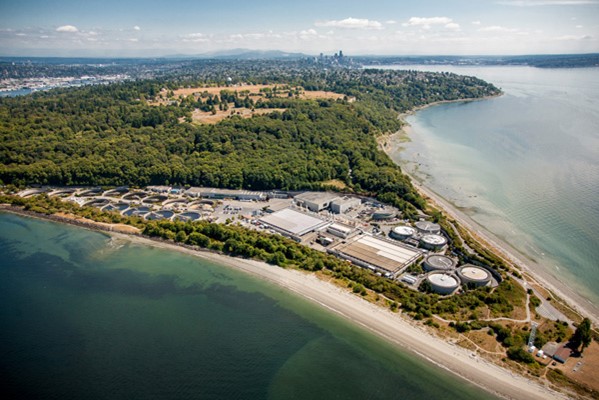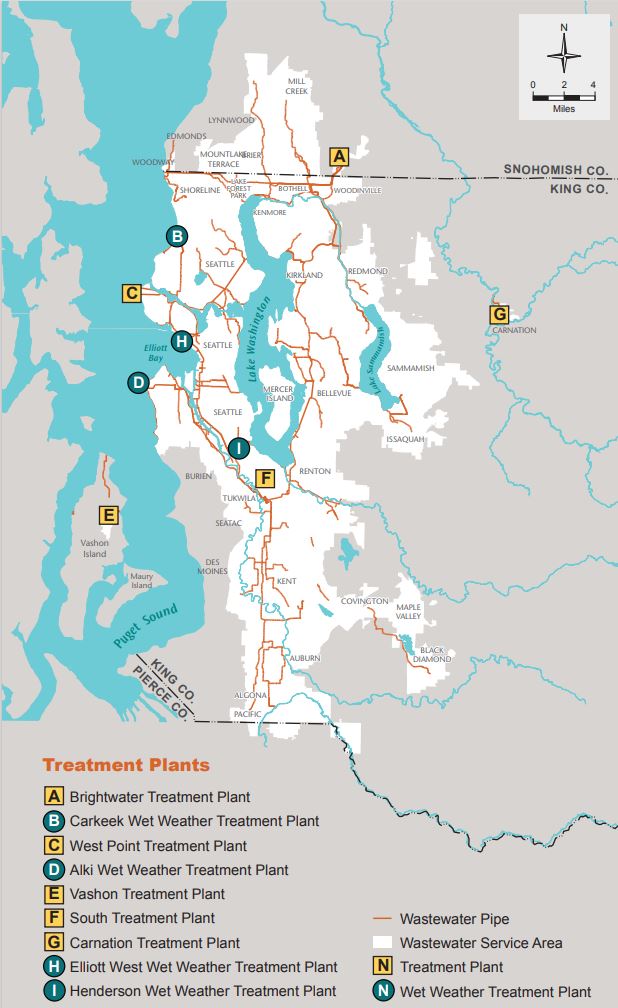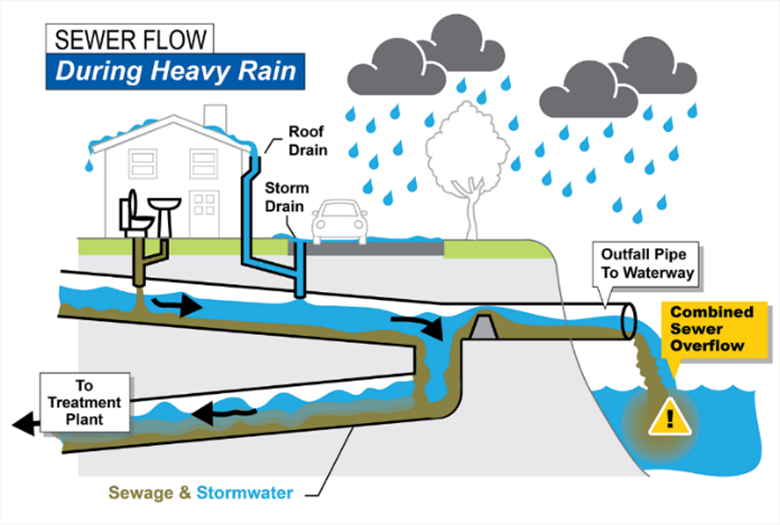
Photo credit: King County
Please note: the comment period has been extended to July 7, 2023.
There are more than 300 municipal wastewater treatment plants in Washington, each with their own unique water quality permit from Ecology. These permits establish the conditions the facility must meet so they can legally discharge treated wastewater to waters of the state, including rivers and Puget Sound. A water quality permit is how the state ensures permittees are not causing or contributing to water quality problems. As part of the permitting process, we regularly update the permit for each facility, revising the permit to reflect any new requirements or changes at the facility.
West Point Treatment Plant
This map, developed by King County, shows their treatment plants. The county also has a new Georgetown Wet Weather Treatment Station coming online soon.
King County owns and operates the largest regional wastewater collection and treatment system in Washington. We regulate the system through permits for their three regional treatment plants, which includes West Point Treatment Plant. As the state’s largest treatment plant, West Point treats sewage from homes and businesses, as well as pre-treated industrial wastewater, collected mostly from within Seattle city limits. The West Point system also treats stormwater runoff collected in combined sewer systems located in various areas of Seattle.
The last water quality permit for the facility became effective in February 2015. The permit was set to expire in 2020, but we administratively extended the permit while we did the necessary work to draft permit updates. We are now starting the public review of the water quality permit for the West Point Treatment Plant.
What is included in the draft permit?
The draft permit includes many requirements common to all water quality permits, including:
- limits on pollutants,
- requirements for monitoring discharge quality,
- testing the toxicity of treated wastewater,
- sampling sediments near outfalls,
- routine reporting along with reporting unusual conditions,
- recordkeeping, and
- operations and maintenance of facilities.
This draft permit updates some of these common requirements to match current Ecology rules and guidance. It also contains requirements unique to the West Point system that are necessary to protect water quality. These include conditions for King County’s industrial wastewater pretreatment program to control pollutants discharged into the collection system by certain industries as well as implementing minimum requirements to control combined sewer overflows (CSO).
We're also proposing some important updates that are specific to the West Point system. We determined these changes are necessary to protect water quality.
These updates include:
PFAS monitoring and source controI
Ecology and the Washington Department of Health are working to minimize the public’s exposure to PFAS — a widely-used class of chemicals that don’t break down naturally in the environment. The draft West Point permit supports these efforts by proposing King County:
(1) Monitor for PFAS in the wastewater it treats
(2) Identify the industries that may discharge PFAS to their treatment system
(3) Work with those industries to control this source of pollution
Nutrient limits for West Point Treatment Plant
This draft permit works in conjunction with the Puget Sound Nutrient General Permit to regulate excess nitrogen from polluting Puget Sound. We removed nitrogen monitoring from the draft permit because it's now addressed in the general permit. All King County wastewater treatment plants must comply with the general permit.
Limits for CSO treatment plants
We are reducing the amount of chlorine King County is allowed to discharge from three of its CSO treatment plants. There are also restrictions on the amount of copper allowed from two CSO treatment plants and zinc from one CSO treatment plant. We must lower these limits to ensure that the CSO treatment plants do not discharge pollutants at levels harmful to aquatic life.
Control pollutants discharged through CSOs
We;re requiring King County to implement best management practices to identify and control sources of pollutants in stormwater that flows into the combined system. The last permit included a similar requirement as part of a CSO pollution prevention program for areas around the Duwamish River. The changes require King County to expand their efforts to include all areas with combined sewers and to ensure their actions align with other pollution source control efforts in the areas around their CSOs.
Redesign of Elliott West CSO Treatment Plant
The Elliott West CSO Treatment Plant has not regularly met limits on its discharge since it began operating in 2005. Ecology’s last permit required King County to conduct two studies to better understand this problem. The county determined that the facility requires major upgrades to achieve compliance with its effluent limits and to protect water quality. The draft permit proposes a schedule King County must follow to redesign and rebuild the facility. Learn more about King County’s CSO treatment facilities.
Why are combined sewer overflows a part of this permit?
Most of the water quality permits for municipal wastewater treatment plants in Washington only regulate the discharge of treated wastewater from a single facility. However, the West Point permit is one of 11 in the state that also regulate discharges of combined sewer overflows. State and federal laws allow communities with combined sewers to discharge CSOs under specific conditions and only in authorized locations. The West Point permit includes the requirements King County must meet to discharge treated and untreated CSOs in a way that protects water quality.
Combined sewer systems capture domestic sewage, pre-treated industrial wastewater discharges, and stormwater runoff into a common pipe for conveyance to a wastewater treatment plant. Communities built combined sewer systems in the early 1900s to 1950s as a simple way to discharge wastewater while preventing flooding and property damage from stormwater or sewage backups.
In areas with combined sewer overflows, rainwater and sewage combine during heavy rain events. This mixture flows into local waterways and to the wastewater treatment plant.
While new combined systems are no longer allowed, some communities like Seattle have a large network of existing combined system infrastructure. During heavy rain events, flows through the combined sewer system dramatically increase and untreated sewage flow diverts directly into the environment at specific locations called combined sewer overflow or CSO outfalls. King County’s combined collection system has 38 of these outfalls.
To help reduce the amount of untreated wastewater leaving CSOs during heavy rain events, King County operates five specialized CSO treatment plants that treat combined sewage before discharging to surface waters. These plants typically operate a few times a year, usually during the winter months. The draft permit includes requirements King County must meet for the discharges from each of these treatment plants to protect water quality. You can check the status of CSO discharges online.
Additional information on the remaining combined sewer systems in the state and the efforts to reduce pollution from these systems is available on our Combined Sewer Overflows webpage.
Addressing power supply issues at West Point
In 2021, Ecology issued an Administrative Order for King County to address a years-long pattern of sewage discharges caused by electrical power supply problems. Under the order, King County must address the electrical issues at the plant and prevent future power disruptions. The order includes specific deadlines for action that the county must meet.
So far, King County has met all deadlines in the order, including submitting a corrective action plan for West Point’s electrical system. The county identified and began implementing modifications at the treatment plant according to the schedule in the plan. The county has completed some projects, and remaining items must be completed by 2025. Projects include replacing critical power supply equipment, installing power monitors, and working on constructing a large battery backup system to help improve power resiliency. They are also working with Seattle City Light to develop long-term strategies to improve power delivery to the treatment plant.
The Administrative Order is separate from the proposed permit updates. Combined, the permit and Administrative Order work together to protect Puget Sound from pollution.
Provide feedback on the permit
We're taking comment on the draft permit until July 7 (extended from the original ending date of June 5). We're holding virtual public meetings and hearings on May 9 and May 16, where you can provide verbal testimony.
Visit our eComment page for instructions on how to submit a written comment.
Attend a virtual meeting
We are also distributing our permit focus sheet in several languages to the South Park, Central, and Ballard public libraries in Seattle.
Ecología creó una hoja informativa para resumir este proceso y destacar cómo el permiso, una vez emitido, ayudará a proteger las aguas superficiales alrededor de Seattle.
生态管理署制作了一个焦点说明书来总结这一过程,并强调许可证一旦颁发将如何帮助保护西雅图周围的地表水域。
주 환경부는 허가 갱신 프로세스를 설명하고 허가 초안에 포함된 조건을 요약하는 포커스 시트를 만들었습니다.
Bộ Môi Sinh đã viết một tờ tiêu điểm để tóm tắt quy trình này và nêu rõ cách thức giấy phép, sau khi được cấp, sẽ giúp bảo vệ vùng nước mặt xung quanh Seattle.



